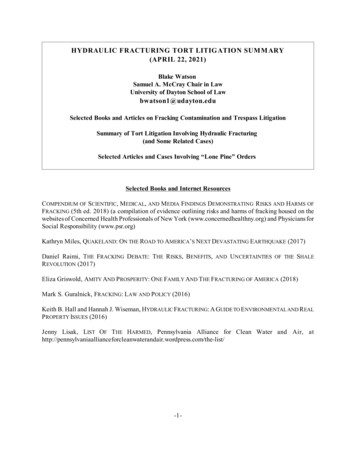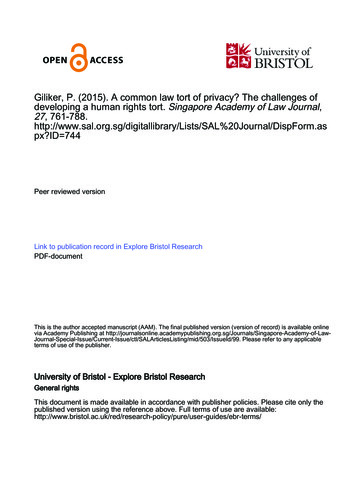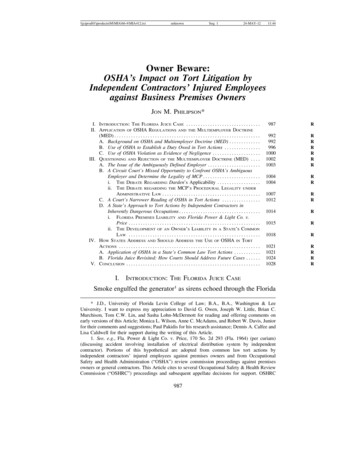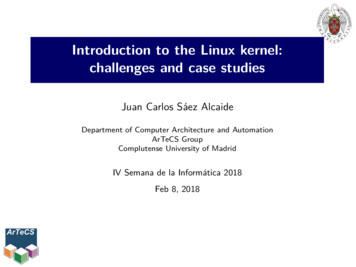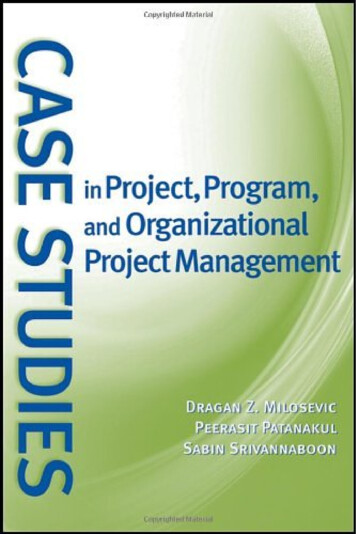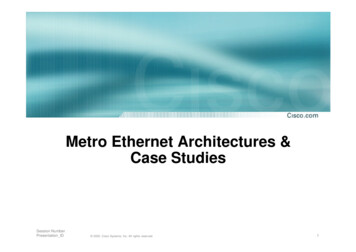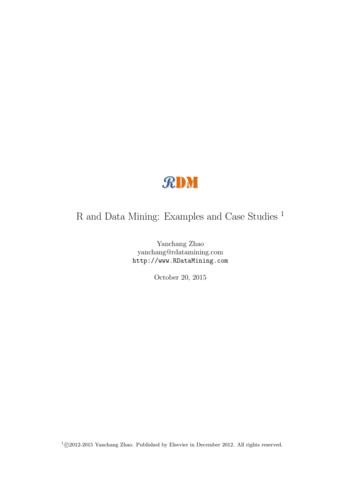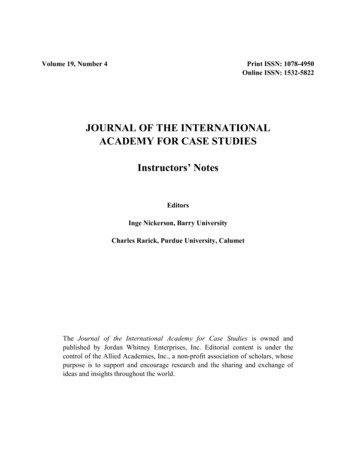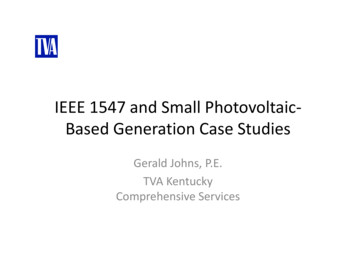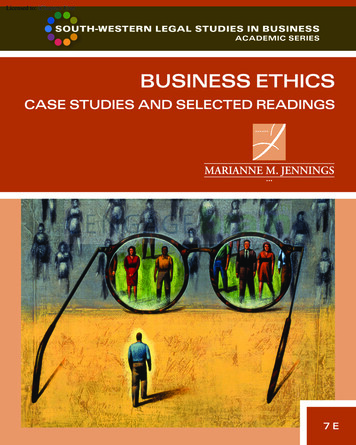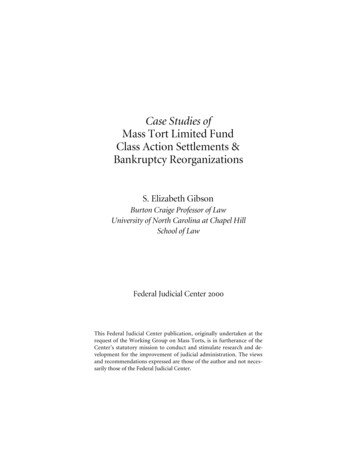
Transcription
Case Studies ofMass Tort Limited FundClass Action Settlements &Bankruptcy ReorganizationsS. Elizabeth GibsonBurton Craige Professor of LawUniversity of North Carolina at Chapel HillSchool of LawFederal Judicial Center This Federal Judicial Center publication, originally undertaken at therequest of the Working Group on Mass Torts, is in furtherance of theCenter’s statutory mission to conduct and stimulate research and development for the improvement of judicial administration. The viewsand recommendations expressed are those of the author and not necessarily those of the Federal Judicial Center.
This page is left blank intentionally to facilitate printing this document double-sided.
ContentsAcknowledgments, ixExecutive Summary, 1The Limited Fund Class Action Settlements, 1White v. Eagle-Picher Industries, Inc., 1Butler v. Mentor Corporation, 2Fanning v. AcroMed Corporation, 2The Bankruptcy Reorganizations, 3In re UNR Industries, Inc., 3In re A.H. Robins, Inc., 3In re Eagle-Picher Industries, Inc., 4In re Dow Corning Corp., 4A Comparison of These Two Mass Tort Resolution Methods, 5Chapter 1. Introduction, 7Preparation of the Case Studies, 9Structure of the Case Studies, 11Chapter 2. Policy Implications of the Case Studies & Conclusions, 13Issues Raised by the Case Studies, 14Fairness of the Resolution Process, 14Effectiveness of Judicial Review of the Resolution, 15Efficiency of the Resolution Process, 17Likelihood That the Resolution Process Will Be Invoked, 17A Comparison of These Two Mass Tort Resolution Methods, 18Fairness of the Resolution Process, 18Effectiveness of Judicial Review of the Resolution, 22Efficiency of the Resolution Process, 25Likelihood That the Resolution Process Will Be Invoked, 26Recommendations, 27Conclusion, 31Chapter 3. Initial Supreme Court Guidance on Limited Fund ClassAction Settlements: Ortiz v. Fibreboard Corp., 33Background of the Case, 33The Supreme Court’s Decision, 35iii
Chapter 4. Aborted Asbestos Limited Fund Class Action: White v. EaglePicher Industries, Inc., 39Nature of Litigation and Litigation Maturity, 40History of the Lawsuit, 41Phase 1: Proceedings Before Special Master Frankel, 42Phase 2: Appointment of Counsel and Negotiations, 45Phase 3: Hearing Before Judge Weinstein, 50Phase 4: Rulings and Their Aftermath, 54Party Structure, 56Attorneys, 58Settlement Terms, 58Negotiation History, 60Handling of Future Claims, 62Notice Procedure and Content, 63Approval and Review Process, 63Attorneys’ Fees, 65Assessment, 66Chapter 5. Asbestos Bankruptcy Reorganization: In re Eagle-Picher Industries, Inc., 69Nature of Litigation and Litigation Maturity, 69History of the Bankruptcy Proceedings, 70Phase 1: Commencement and Initial Skirmishing, 70Phase 2: Mediation, 75Phase 3: Skirmishing with Unsecured Creditors and Shareholders,76Phase 4: Compromise and Confirmation, 80Phase 5: Postconfirmation, 83Party Structure, 85Attorneys, 85Terms of the Reorganization Plan, 85Asbestos Personal Injury Claims, 86Other Tort and Environmental Claims, 88Other Unsecured Claims, 90Equity Interests, 90Negotiation History, 90Handling of Future Claims, 91iv
Notice Procedure and Content, 95Approval and Review Process, 97Attorneys’ Fees, 98Assessment, 98Chapter 6. Breast Implant Limited Fund Class Action: Butler v. MentorCorporation, 101Nature of Litigation and Litigation Maturity, 102History of the Lawsuit, 103Party Structure, 109Attorneys, 109Settlement Terms, 109Negotiation History, 111Handling of Future Claims, 113Notice Procedure and Content, 113Approval and Review Process, 116Proponents’ Evidence in Support of Class Certification and theSettlement, 116Objections, 118Final Order Approving Settlement and Certifying Class, 119Attorneys’ Fees, 121Assessment, 122Chapter 7. Orthopedic Bone Screws Limited Fund Class Action: Fanningv. AcroMed Corporation, 127Nature of Litigation and Litigation Maturity, 127History of the Lawsuit, 131Party Structure, 136Attorneys, 137Settlement Terms, 138Negotiation History, 140Handling of Future Claims, 142Notice Procedure and Content, 142Approval and Review Process, 143Conduct of the Hearing, 144Proponents’ Evidence in Support of the Existence of a LimitedFund, 146Objections, 148v
Court’s Ruling on the Objections, 149Standards for Class Certification, 150Standards for Approval of the Settlement, 152Dismissal of Appeals, 153Attorneys’ Fees, 154Assessment, 155Chapter 8. Other Mass Tort Bankruptcies: UNR, A.H. Robins, and DowCorning, 159In re UNR Industries, Inc., 159Nature of Litigation and Litigation Maturity, 160History of the Bankruptcy Proceedings, 160Party Structure, 174Attorneys, 175Terms of the Reorganization Plan, 176Negotiation History, 178Handling of Future Claims, 180Notice Procedure and Content, 181Approval and Review Process, 182Attorneys’ Fees, 183Assessment, 185In re A.H. Robins Company, Inc., 187Nature of Litigation and Litigation Maturity, 188History of the Bankruptcy Proceedings, 190Party Structure, 200Attorneys, 201Terms of the Reorganization Plan, 202Negotiation History, 204Handling of Future Claims, 207Notice Procedure and Content, 209Approval and Review Process, 211Attorneys’ Fees, 213Assessment, 214In re Dow Corning Corporation, 217Nature of Litigation and Litigation Maturity, 218History of the Bankruptcy Proceedings, 220Party Structure, 227vi
Attorneys, 227Terms of the Reorganization Plan, 228Negotiation History, 230Handling of Future Claims, 230Notice Procedure and Content, 231Approval and Review Process, 232Attorneys’ Fees, 236Assessment, 236Appendix: Case Summaries, 239vii
This page is left blank intentionally to facilitate printing this document double-sided.
AcknowledgmentsI am grateful to the Federal Judicial Center and especially to TomWillging for providing me the opportunity to undertake the case studiesincluded in this monograph, initially in the form of a report to theWorking Group on Mass Torts and later in the present expanded version.Tom’s conception of the project; his insights, guidance, and patiencealong the way; and his cheerful companionship on our travels to visitcourts and lawyers in the summer of 1998 contributed greatly to value ofthis study, both to me personally and, more importantly, to courts andpolicy makers who are grappling with the difficult issues presented bymass torts.I also wish to thank the numerous lawyers, judges, and court officialswho were generous in sharing their time and memories with us as we attempted to reconstruct the histories of the cases studied in this monograph. Regardless of the questions that might be raised with the benefit ofhindsight concerning the resolution methods used, it is clear that thejudges and lawyers involved in these cases deserve recognition for thecare, creativity, and good intentions they displayed in seeking fair andefficient solutions for mass tort problems facing them.My undertaking of this project has been supported throughout itscourse by the University of North Carolina School of Law, and I appreciate my school’s and colleagues’ interest and encouragement. CindySinger Cafaro provided helpful research assistance in the summer of1999, for which I thank her. For almost a year Matt Stiegler worked tirelessly with me on this project, serving as research assistant, collaborator,editor, and friend. The teacher learned much from the student, and it ishard for me to imagine how this monograph could have been writtenwithout him. I will be forever grateful to him.Finally, I want to thank my family—Bob, Daniel, and Benjamin—fortheir unflagging love and support. They provided encouragement on allthe occasions that I needed it, and they wisely learned to stop asking,“When will your project ever be finished?” This monograph is dedicatedto them.ix
Executive Summary This monograph examines three limited fund class action settlements ofmass tort claims (including one settlement attempt that was abandonedin favor of bankruptcy) and four bankruptcy reorganizations precipitatedby mass tort litigation. Each case is unique in the circumstances that precipitated it and the dynamics of its proceedings. Despite those differences, an examination of the class action settlements as a group in contrast to the bankruptcy reorganizations that were studied allows somecomparisons about the fairness and effectiveness of these two means ofachieving global resolutions of mass tort liabilities.The Limited Fund Class Action SettlementsWhite v. Eagle-Picher Industries, Inc.In 1990 Eagle-Picher Industries, Inc. sought to use a class action underFederal Rule of Civil Procedure 23(b)(1)(B) to cap its tort liability. Itseffort to achieve a limited fund settlement of all its present and futureasbestos claims met with great opposition, however, and eventually wasabandoned in favor of a Chapter 11 reorganization. Without engaging inany prior negotiations with plaintiffs’ counsel, Eagle-Picher tried to get alimited fund class action certified so that a non-opt-out settlement couldbe negotiated. The defendant pursued this strategy before a supportivejudge, who had grown frustrated at the existing, costly methods of resolving asbestos claims. The failure to obtain the support of or to allowthe direct involvement of lawyers who might have been opinion leadersof the diverse, largely autonomous asbestos plaintiffs’ bar contributed inlarge measure to the opposition that the attempted settlement faced. Theproposed settlement, which provided for the payment of some 505 million to the plaintiff class over a twenty-year period, was perceived as apro-defendant solution that was being forced on plaintiffs by EaglePicher, the court, and the court’s handpicked lawyers. The size of thelimited fund (i.e., the value of the company along with any insurancecoverage) was never established.1
Butler v. Mentor CorporationMentor Corporation successfully achieved a limited fund settlement of itsbreast implant litigation by means of a Rule 23(b)(1)(B) settlement classin 1993. It first engaged in negotiations with members of the plaintiffs’steering committee in the breast implant multidistrict litigation (MDL)proceedings. Mentor reached a settlement agreement before it initiatedthe class certification proceedings and thus was able to present withplaintiffs a joint application for class certification and approval of thesettlement to the court. The company benefited from the substantial efforts made by the MDL plaintiffs’ lawyers to explain and sell the settlement to breast implant plaintiffs’ lawyers around the country. The approval process was largely nonadversarial, and few objections were madeby members of the plaintiff class. In the end, the settlement provided forMentor’s payment of 25.8 million over a three-year period into a settlement fund. The fund was eventually distributed on a basis that required no proof of injury and drew no distinctions based on severity ofinjury.Fanning v. AcroMed CorporationIn 1997 AcroMed Corporation, a manufacturer of orthopedic bonescrews, achieved a Rule 23(b)(1)(B) class action settlement of the masstort litigation it faced, over the substantial opposition of a codefendantand several class members. After reaching agreement on the terms of asettlement with the MDL plaintiffs’ legal committee, AcroMed and thePlaintiffs’ Legal Committee (PLC) jointly sought certification of a limitedfund class and approval of the settlement. The court conducted a lengthyfairness hearing, at which the codefendant presented the testimony of anexpert who disputed the proponents’ evidence concerning the existenceof a limited fund. The court certified a plaintiff class pursuant to Rule23(b)(1)(B) and approved the settlement, relying in part on the testimony of the PLC’s expert that, freed of the tort claims against it, AcroMed would be worth 104 million. A few months later, the company wassold for more than three times that amount. One group of class membersapparently obtained a more favorable treatment than the rest of the classin exchange for agreeing to drop their appeals.2Mass Tort Limited Fund Class Actions & Bankruptcy Reorganizations
The Bankruptcy ReorganizationsIn re UNR Industries, Inc.Initiating one of the first mass tort bankruptcies, UNR Industries, Inc.filed a Chapter 11 petition in 1982 in order to obtain a resolution of itsasbestos liability. Because of the unprecedented nature of the bankruptcy,negotiations got off to a slow start. Among the issues that the debtor firstsought to resolve was its authority to include future claims in its reorganization plan and discharge. Once that issue was decided in UNR’s favor, the debtor left it up to the unsecured creditors’ committee, the asbestos claimants’ committee, and the future claims representative to negotiate the appropriate basis for dividing assets between commercialclaimants and asbestos disease claimants. Eventually the group arrived ata 1-to-2.27 ratio, which served as the basis for the reorganization plan.The parties then negotiated the share of equity that the shareholderswould be permitted to retain, agreeing on 8% of the reorganized company’s stock. The reorganization plan created a trust to pay asbestos disease claimants. The trust received a controlling share (63%) of the reorganized company’s stock, which at the time of distribution had a marketvalue of 150 million. The plan was confirmed consensually in 1989, allimpaired classes having voted overwhelmingly to approve it. Payouts bythe trust did not commence until late 1991.In re A.H. Robins, Inc.A.H. Robins, Inc. filed for bankruptcy in 1985, seeking to bring an end tothe litigation it faced which arose out of its manufacture and sale of abirth control device, the Dalkon Shield. With the active participation of adistrict judge, who withdrew the reference to the bankruptcy court as tomost matters, the debtor was able to obtain consensual confirmation of areorganization plan in 1988. Following the establishment of a bar date(the deadline for filing proofs of claim) for tort claims and the creation ofan extensive database concerning the nature of the claims that were filed,the district judge conducted an estimation hearing and established thevalue of the debtor’s tort liability at 2.475 billion. With the liabilitycapped at this amount, the company became more attractive to potentialbidders. Eventually the company was sold in accordance with terms thatwere acceptable to all constituencies. The purchaser provided the fundingfor a 2.3 billion trust for Dalkon Shield claimants, which ended up pay-Mass Tort Limited Fund Class Actions & Bankruptcy Reorganizations3
ing all of the tort claims in full (as determined by the trust’s resolutionprocedures, which encouraged settlement). Not only the debtor but alsoits officers, directors, successors, and insurers were released from anyfurther tort liability as a result of the bankruptcy.In re Eagle-Picher Industries, Inc.Following its unsuccessful effort to obtain a limited fund class action settlement of its asbestos liability, Eagle-Picher filed for bankruptcy in 1991.The proceedings moved slowly at the beginning, but the appointment ofa mediator to assist the parties in negotiating the terms of a plan eventually yielded results. The debtor was able to reach agreement with the asbestos claimants’ committee and the future claims representative over thevalue of the asbestos claims and the general terms of a reorganizationplan. However, the unsecured creditors’ committee refused to accept thatthe asbestos claims were ten times greater in amount than the commercial claims. Eventually this stalemate required a judicial estimation of thevalue of the asbestos claims. The bankruptcy court ended up estimatingthe claims to be worth 1 billion more than the amount the debtor andasbestos claimants had previously agreed to. Eventually, the unsecuredcreditors’ committee agreed to a compromise amount 500 million lessthan the court had estimated, and the plan was drafted on that basis. Under the plan, all of the stock of the reorganized company went to a trustcreated to pay the asbestos claims, and the existing shareholders receivednothing. Because the shareholders were deemed to reject the plan and theclass of unsecured creditors voted to reject it (owing to the negative votesof a few large creditors), the plan had to be crammed down (i.e., judicially approved over the objection of the rejecting classes). In 1996 thebankruptcy court, sitting jointly with the district court, confirmed theplan. Fifteen months later the trust sold the company for over 700 million.In re Dow Corning Corp.Dow Corning Corporation filed for bankruptcy in 1995, following its unsuccessful attempt in the MDL proceedings to arrive at a global settlement of its breast implant litigation. The company was able to use bankruptcy to consolidate the litigation against not only itself, but also its twoshareholders. Although the debtor never succeeded in getting a trial ofthe disease-causation issue in the bankruptcy or district court, it did4Mass Tort Limited Fund Class Actions & Bankruptcy Reorganizations
eventually reach an agreement with the tort claimants’ committee on theterms of a reorganization plan that they jointly proposed. Under the plan,Dow Corning was obligated to pay a maximum of 3.17 billion over sixteen years for breast implant claims, but the plan allowed the reversion tothe debtor of any funds not needed to satisfy the claims. Because threeclasses—commercial creditors, Norplant claimants, and governmentpayers—voted to reject the plan, it had to be crammed down. The bankruptcy court confirmed the plan in 1999, although it ruled that the planhad to be interpreted as preserving the claims against nondebtor partiesof breast implant claimants who had not voted to accept the plan. Thedistrict court affirmed the plan confirmation, but reversed the bankruptcy court’s interpretation of the release as being limited to acceptingclaimants.The Appendix to this monograph contains summaries of the keyfeatures of each of the cases studied.A Comparison of These Two Mass Tort ResolutionMethodsBased on the cases included in this study, in Chapter 2 I compare limitedfund class action settlements with bankruptcy reorganizations, focusingon four criteria: fairness of the resolution process, effectiveness of judicialreview of the resolution, efficiency of the resolution process, and likelihood that the resolution process will be invoked. I conclude that bankruptcy comes out ahead of limited fund class action settlements with respect to the fairness of the resolution process and the effectiveness of judicial review. The confirmation requirement of voting by individualcreditors (including tort claimants), the substantive bankruptcy protections for individuals and classes that vote against the plan, and the practice of appointing a future claims representative provide greater protection and opportunity for input for absent tort claimants than is availableto them when a district court approves a limited fund class action settlement. Moreover, tort claimants are treated more equitably in a bankruptcy reorganization with respect to the defendant’s other creditors, because all are forced to share the defendant’s shortfall; in a limited fundclass action settlement, only the tort claimants are forced to compromisetheir claims.Judges presiding over bankruptcy reorganizations also have the advantage of having specific statutory standards for the confirmation of theMass Tort Limited Fund Class Actions & Bankruptcy Reorganizations5
reorganization plan. The standards for determining whether a limitedfund class should be certified and whether a settlement should be approved, by contrast, remain ill defined. While neither method appears tohave an advantage when it comes to estimating the defendant’s total masstort liability, a difficult task regardless of the resolution method used,bankruptcy judges are likely to have more expertise than district judges indeterminin
The Bankruptcy Reorganizations, 3 In re UNR Industries, Inc., 3 In re A.H. Robins, Inc., 3 In re Eagle-Picher Industries, Inc., 4 In re Dow Corning Corp., 4 A Comparison of These Two Mass Tort Resolution Methods, 5 Chapter 1. Introduction, 7 Preparation of the Case Studies, 9 Structure of the Case

